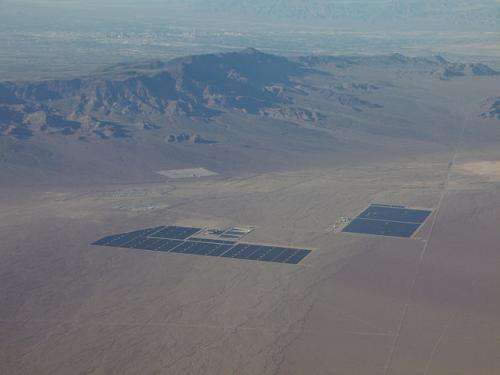A photograph of w:Nevada Solar One and Copper Mountain Solar 1. Credit: Michael Adams
(Phys.org) —A team of researchers from Carnegie Mellon University has published a paper in the journal Proceedings of the National Academy of Sciences suggesting that governments and utility companies rethink where renewable resource plants are built. They claim that building solar or wind farms in regions that currently rely heavily on burning coal to produce electricity provides far more societal benefits than building similar plants in parts of the country that currently use much cleaner gas-fired plants.
To come up with a way to measure the societal value of building solar or wind farms, the researchers attached a monetary value to the pollution currently created by power plants—$20 per ton for carbon dioxide emitted. They did the same with costs associated with people dying from air pollution emitted from power plants—arriving at $6 million per person. Using these numbers, they were able to calculate how much money a region would save if they replaced current electricity plants with wind or solar farms. In so doing, they found a wide range, from $10 per megawatt hour in Arizona to $100 in several northeastern states.
The overall point the researchers are trying to make is that it doesn't always make the most sense to put a renewable resource farm in a region based solely on how efficiently it will perform there. Solar farms in the southeast part of the country, for example, produce far more electricity than do the same types of farms in northern areas—they get more sunshine. Similarly, wind farms vary in efficiency depending on where they are placed—but if a solar or wind farm displaces far more pollutants in the north than in the south, than more should be built there, despite their being far less efficient in those regions.
The researchers also note that their calculations show that the entire country is currently saving about $2.6 billion annually due to wind and solar farm output, which they note is 60 percent more than the government spent subsidizing just wind plants. A good return on investment, the team says, but one that could be much better if the government switched its focus from rewarding those plants that produce the most electricity, to those that displace the most pollutants.
More information: Siler-Evans, K., Lima Azevedo, I., Morgan M. G. & Apt, PNAS doi: 10.1073/pnas.1221978110 (2013).
Abstract
When wind or solar energy displace conventional generation, the reduction in emissions varies dramatically across the United States. Although the Southwest has the greatest solar resource, a solar panel in New Jersey displaces significantly more sulfur dioxide, nitrogen oxides, and particulate matter than a panel in Arizona, resulting in 15 times more health and environmental benefits. A wind turbine in West Virginia displaces twice as much carbon dioxide as the same turbine in California. Depending on location, we estimate that the combined health, environmental, and climate benefits from wind or solar range from $10/MWh to $100/MWh, and the sites with the highest energy output do not yield the greatest social benefits in many cases. We estimate that the social benefits from existing wind farms are roughly 60% higher than the cost of the Production Tax Credit, an important federal subsidy for wind energy. However, that same investment could achieve greater health, environmental, and climate benefits if it were differentiated by region.
Journal information: Proceedings of the National Academy of Sciences
© 2013 Phys.org























